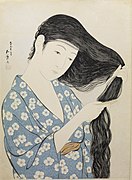Hashiguchi Goyō
Hashiguchi Goyō ( Japanese 橋 口 五 葉 ; * December 21, 1880 in Kagoshima , Kagoshima Prefecture ; † February 24, 1921 ) was a Japanese woodblock print artist, the first of the Shin-hanga direction.
life and work
He was born Hashiguchi Kiyoshi ( 橋 口 清 ) in Kagoshima as the son of a traditional style painter. Hashiguchi became interested in the Kanō school at an early age and went to Kyoto in 1899 to study under Hashimoto Gahō. However , he was persuaded to study Western painting by the then influential painter Kuroda Seiki , who hails from the same area. Hashiguchi therefore went to Tokyo and studied at the private art school Hakuba-kai, from which he graduated in 1905. His older brother, the painter Hashiguchi Yasuo, introduced him to the writer Natsume Sōseki . He commissioned him to design the cover for the novel Ich der Kater ( Wagahai wa neko dearu ), which appeared in 1905. Hashiguchi then designed almost 70 other book covers in the Art Nouveau style.
Hashiguchi's paintings were shown in a 1907 Tokyo Industrial Exhibition and in the first exhibition organized by the Ministry of Culture , Mombushō Bijutsu Tenrankai , but given that he had only moderate success, he gave up oil painting.
In 1911, Hashiguchi won the competition for a poster for the Mitsukoshi clothing store depicting a modern Japanese woman. At the time, the publisher and art dealer Watanabe Shōzaburō ( 渡邊 庄三郎 ; 1885–1962) was looking for artists who could transfer the traditional Japanese woodcut of the 18th century ( Ukiyo-e ) into the present. So he got in touch with Hashiguchi, whose poster he had noticed. Hashiguchi then created the template for the first print of the new kind ( Shin-hanga ) with the title "In the bathroom" (
But to have control over the printing process himself, Hashiguchi had the following prints made in his own workshop. In the years 1916 to 1917 he published the twelve-volume collection Ukiyo-e fūzoku Yamato nishiki-e ( 浮世 風俗 や ま と 錦 繪 ) with hundreds of miniaturized reprints by earlier masters. In addition, he created other original prints of beautiful women ( bijinga ). Other prints that were unfinished at his untimely death were published by his family.
photos
Remarks
- ^ Hashimoto Gahō (1835-1908) was one of the last artists of the Kanō school.
- ↑ 化粧 の 女 , Keshō no onna
- ↑ 温泉 宿 , Onsen-yado
- ↑ 夏衣 の 女 , Natsugoromo no onna
literature
- Lawrence Smith: Modern Japanese Prints (1912-1989). Cross River Press, New York. 1994. ISBN 1-55859-871-5 .
- Helen Merritt: Modern Japanese Woodblock Prints. University of Hawaii Press, 1990. ISBN 0-8248-1200-X .
Web links
| personal data | |
|---|---|
| SURNAME | Hashiguchi, Goyō |
| BRIEF DESCRIPTION | Japanese woodblock artist |
| DATE OF BIRTH | December 21, 1880 |
| PLACE OF BIRTH | Kagoshima , Kagoshima Prefecture |
| DATE OF DEATH | February 24, 1921 |
- ↑ 千葉 市 美術館. In: www.ccma-net.jp. Retrieved September 8, 2015 .
- ↑ 髪 梳 け る 女 . In: Machida City Museum of Graphic Arts. Retrieved September 8, 2015 (Japanese).








